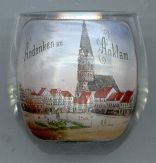

|
| DEUTSCHLAND | GERMANY |
| Bundesland: Mecklenburg-Vorpommern | Mecklenburg-West Pomerania |
| Landkreis: Vorpommern-Greifswald |
Anklam is situated at the mouth of the river Peene at the coast of the Baltic Sea.
It was first mentioned in 1243 and was chartered as a town in 1264. In 1283 Anklam became
a member of the Hanse federation of trading towns. During the Thirty Years' War it was occupied
first by Imperial and then by Swedish troops. At the end of the war, in 1648, it became part of Sweden.
In 1711 it was occupied by the allied army of Saxony, Russia, Denmark, Poland and Prussia.
In 1720 one part of Anklam up to the river Peene became Prussian. After a brief period of
French occupation (1606–1608) during the Napoleonic Wars, the whole town became part
of Prussia in 1815. During World War II about 70% of the old town were destroyed between 1943 and 1945.
After the re-unification of Germany in 1990, the prefix 'Hansestadt' was again added to the city's name.

The  Marienkirche (church of Our Lady) [left]
The church was first mentioned in 1296. The late Romanesque and Gothic structure dates back to the
13th century. The nave was built in the second half of the 14th century. During the 15th century
the church was enlarged. Originally it should have received two towers but only the southeast
tower (almost 100 m high) was completed. In place of the second tower the Lady chapel
was added in 1488. After a fire in 1887 the tower received a high Neo-Gothic spire in 1887.
The church was destroyed in 1943 but was rebuilt between 1945 and 1947.
Marienkirche (church of Our Lady) [left]
The church was first mentioned in 1296. The late Romanesque and Gothic structure dates back to the
13th century. The nave was built in the second half of the 14th century. During the 15th century
the church was enlarged. Originally it should have received two towers but only the southeast
tower (almost 100 m high) was completed. In place of the second tower the Lady chapel
was added in 1488. After a fire in 1887 the tower received a high Neo-Gothic spire in 1887.
The church was destroyed in 1943 but was rebuilt between 1945 and 1947.
The aeronautic pioneer Otto LILIENTHAL (1848–1896) was born in Anklam.
>
The Polish name for Anklam is Nakło (nad Pianą). Another glass in this collection shows a view of Nakło nad Notecią, Poland.
![[scale]](lineal.jpg)